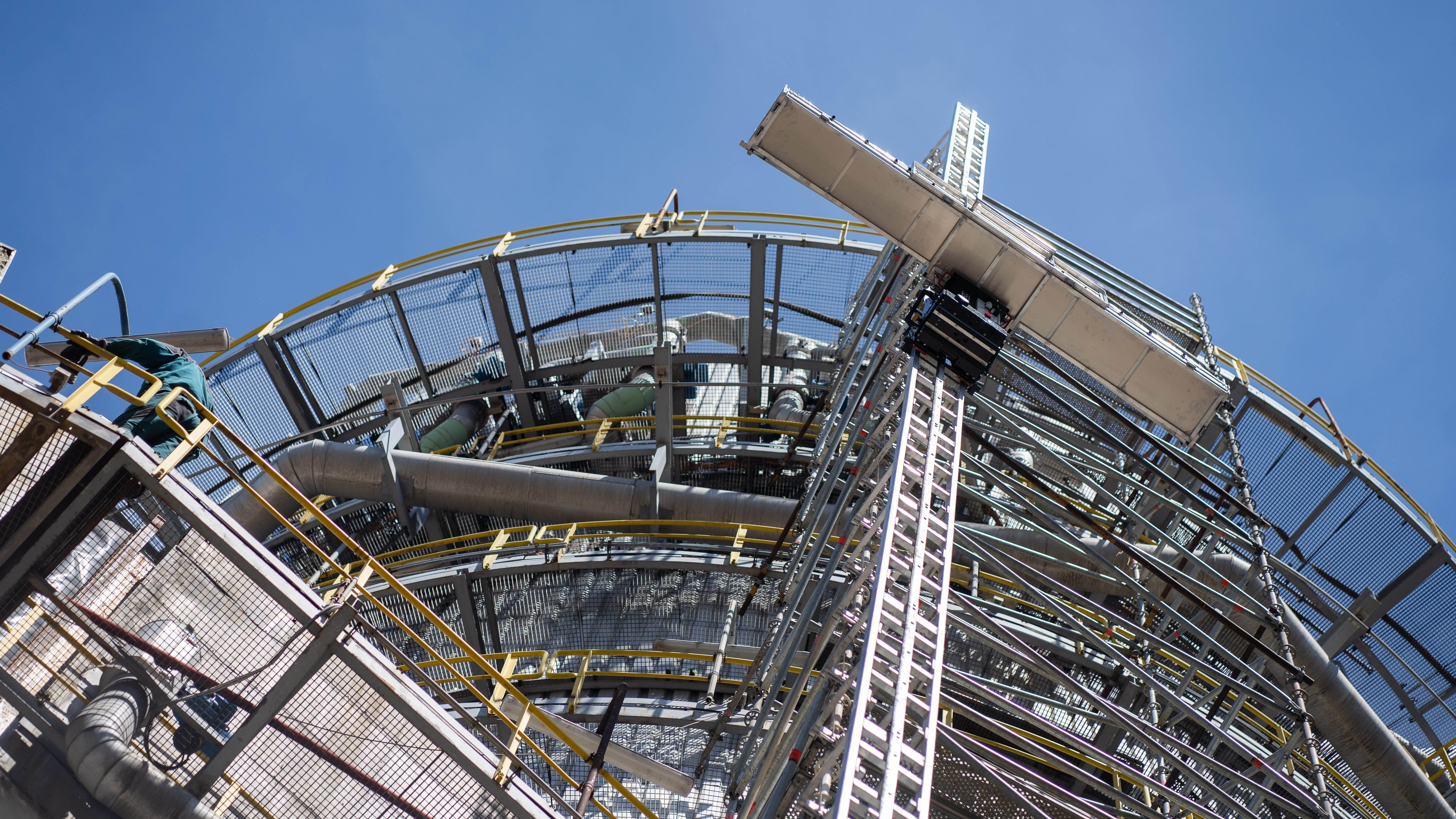Zero Emission Jobsites: A Realistic Goal for Sustainable Construction?
Author
Matt Wheelis
SVP Strategy for the Build & Construct Division at Nemetschek Group
This article belongs to the collection Sustainability
To the topic pageImagine a fossil-free jobsite – one where we are not consuming petrochemical-based fossil fuels and with zero on-site emissions. It is not as big a stretch as it initially sounds. Disregarding vehicular energy requirements, which may still require fossil fuels for generations depending upon the location, for this conversation let’s focus on emissions at the site:
Is “zero emission” a realistically attainable goal? In fact, it is not only possible, but available today – for those willing to make the investment and test new processes on their next construction site.
Electric Battery vs. Hydrogen-Powered Construction Equipment
A zero-emission jobsite, with no fossil fuel consumption, means we have to create a zero-emission construction fleet. It may not be as far-fetched as it initially appears. There are already options for those willing to make the leap – electric battery or hydrogen-powered equipment.
Battery-powered machinery is a great option, with potential range capabilities per charge or fueling equal to or greater than gasoline or diesel. The downside: these technologies require two to eight hours to recharge assuming a high-voltage source, which leads to inefficiencies and project downtime. Hydrogen, on the other hand, has the same range as battery-powered machinery without the downtime associated with refueling.
The long-term savings achievable with these technologies can easily offset the upfront costs of switching from gasoline or diesel machinery, while contributing to the fossil fuel-free worksite.
Converting Existing Machinery to Hydrogen
It is also possible to convert existing gasoline or diesel equipment models to hydrogen with minimal machine redesign. This can be achieved by converting to a hydrogen combustion engine, which operates similarly to traditional internal combustion engines (ICE), with cylinders pumping compressed hydrogen gas rather than gas or diesel. Just like an ICE, a spark ignites the hydrogen gas, creating power to drive the machinery. This can often be a more affordable and simpler option to reduce fossil fuel consumption on the jobsite.
Balancing Sustainability and Cost
However, a challenge with burning hydrogen in internal combustion engines is the possibility of pollutant emissions such as NOx and particulate matter (PM) being produced. These are harmful to human health – in fact, GeoHealth finds that eliminating pollutant emissions from energy-related activities, including construction, could prevent more than 50,000 deaths a year in the US. Because of this there is increasingly stringent legislation against them. One way of reducing the levels of NOx produced involves increasing the amount of air in the combustion chamber, but this reduces efficiencies. Another way is to favor an engine that takes the “flame” out of the combustion reaction altogether. As the harmful pollutants in question are formed around a flame, this approach is extremely effective at eliminating them.
Hydrogen fuel cells use a catalyst to generate electricity through a chemical reaction. With this method, hydrogen is held in a fuel cell on the machinery itself and is powered through a negative electrode terminal – hydrogen is funneled between an electrolyte and another positive electrode terminal. This creates a chemical reaction that results in a continuous flow of electricity to the batteries. Naturally, this seems like the best option because of the continuous creation of energy, but it is more complicated and expensive to implement.
Other solutions use a flameless combustion reaction to generate electricity from fuels. This technology can be fuel-agnostic, using flameless combustion technology, which uses high temperature exhaust heat recovery to unlock pollutant-free power from any fuel at the flick of a switch. With hydrogen being just one option for fossil-free fuel, this approach enables contractors to leverage whichever renewable fuel is most cost-effective and abundant at any one time.
It’s important to protect profit margins from dramatic fluctuations by enabling balance between sustainability and cost throughout the energy transition on a project-by-project, day-by-day basis. This means sites can deploy fuel-agnostic generators at scale today and see immediate carbon and pollution reduction benefits – much to the benefit of site teams, the environment and the local community, offering an alternative and lower-risk entry point for transitioning to fossil fuel-free jobsite.
The Environmental Impact of Hydrogen: Safety Concerns and Storage Challenges
So, what are other downsides of using hydrogen as an energy source? The biggest is safety. Hydrogen has a small molecular size, so if it leaks through solids and mixes with air, it can be explosive, similar to gasoline or diesel. It is also not naturally occurring, so it has to be extracted from fossil fuels, compressed and then used to create a chemical reaction, converting energy into electricity to power electric motors on the construction machinery.
Storage tank infrastructure is critical to safety with hydrogen and hydrogen fuel cell technology. OEMs have to create space for hydrogen storage tanks since they are bulkier than tanks holding liquid gasoline or diesel fuel. The much larger footprint required of hydrogen storage poses a challenge in terms of energy security.
While a 1,000-liter diesel bowser provides three to four weeks of power, the same footprint of hydrogen gives enough power for only two to three days. Consider also that the hydrogen supply chain is much less mature than that of diesel and comes with much more uncertainty, so switching to hydrogen means businesses face a significantly increased risk of project delays. The penalty for this is fines, which impact already-narrow profit margins.
The integrity of storage tanks is vital because of the volatility of hydrogen. A leak could do considerably more damage than good to our environment without proper design and care. Short term, a hydrogen leak would have 33 times the global warming potential as CO2. Even with the best intentions, we would be setting ourselves back even further in our efforts. Still, CO2 lingers in the atmosphere longer than hydrogen, meaning the long-term effects are potentially more severe. For these reasons, focus needs to be on deploying carefully crafted systems for producing, distributing and using hydrogen.
Weighing Emission Savings Against Carbon Footprint
Do emissions saved from using hydrogen outweigh the fossil fuels required to produce it, which requires the use of fossil fuels, most commonly natural gas? This contributes to a carbon footprint that can be greater than natural gas-fired power due to the construction of fuel cells and the logistics involved in compressing, transporting and then either combusting or converting hydrogen to electricity in a fuel cell.
While the goal is to get to hydrogen produced using surplus green electricity from wind and solar, with only about 44% of the UK’s total energy demand today delivered by renewable, we still have a long way to go to scale this infrastructure sufficiently to produce the amount of green hydrogen we need to displace the amount of diesel used in the construction industry alone. We have to take the whole lifecycle of producing hydrogen into account to ensure that there isn’t a greater carbon footprint produced in the transition to hydrogen power.
Fossil Fuel-Free Jobsites: A Call to Action for the Construction Industry
Are there companies focused on creating the infrastructure and machinery needed to implement this zero-emission construction fleet? Absolutely.
Reducing our carbon emissions on the jobsite is not only beneficial for our planet, but also provides a cleaner and safer environment for people working on jobsites. This is critically important to attract talent and a labor force that is currently lacking and in need. Our next generation of talent highly values companies that are innovative and proactively taking measures to improve sustainability.
A fossil fuel-free jobsite is possible through a construction fleet that is either electric or hydrogen powered, and there are many OEM companies paving the way for the construction industry to decrease its carbon footprint in a very tangible way.





